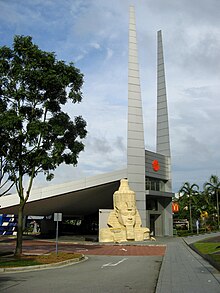Science Centre Singapore
 Entrance of the Science Centre | |
 Location within Singapore | |
Former name | Singapore Science Centre |
|---|---|
| Established | 10 December 1977 |
| Location | 15 Science Centre Road, Singapore 609081 |
| Type | Science museum Public Government |
| Agency overview | |
| Jurisdiction | Government of Singapore |
The Science Centre Singapore (SCS, previously known as Singapore Science Centre)[1] is a scientific institution in Jurong East, Singapore, specialising in the promotion of scientific and technological education for the general public. It houses over 850 exhibits over eight exhibition galleries and receives over a million visitors every year. In 2003, it celebrated its silver jubilee.
History[]

The Science Centre was carved out of the National Museum of Singapore as a separate institution so that the latter could focus on its artistic and historical collections. This idea was first mooted in 1969 by the former Science Council of Singapore, now known as the Agency for Science, Technology and Research (A*Star), and was approved by the government.
The SCS building's design was decided by an architectural competition organised by the Science Centre Board, in which Raymond Woo architects' entry was selected. Built at a cost of S$12 million on a 60,000-square-metre (650,000 sq ft) site in Jurong East, it was officially opened on 10 December 1977 by Dr. Toh Chin Chye, the Minister-in-charge of the centre.
In 1987, the centre saw a significant expansion with the opening of Singapore's first and only OMNIMAX theatre, the Omni-Theatre. Costing $18 million, it has a 276-seat theatre underneath a 23-metre (75 ft) tilted dome.
In 1999, a $38 million renovation expanded the centre's exhibition space with larger open areas, a direct connection to the separate Omni-Theatre building, as well as a new entrance. In 2000, Snow City, a recreation of a −5 °C (23 °F) environment in tropical Singapore, was set up beside the Omni-Theatre.
On 7 December 2007, in its 30th anniversary year, the centre rebranded itself as the Science Centre Singapore (SCS).
Observatory[]

Location[]
The Science Centre Observatory is situated at 1°20′03″N 103°44′09″E / 1.3342°N 103.7357°E, and is 15.27 metres (50.1 ft) above mean sea level. It is one of the few observatories in the world located next to the equator. Its unique position allows constellations in both the northern and southern celestial hemispheres to be observed.
Telescope[]
The main telescope of the Observatory is a 40-centimetre (16 in) Cassegrain reflector of a combined focal length of 520 centimetres (200 in).[2] The sub-telescope is a 15-centimetre (5.9 in) apochromatic Kepler refractor with a focal length of 180 centimetres (71 in). The equatorial mount for the telescopes was designed for Singapore's unique location; the accompanying English yoke provides the stability needed for the drive and tracking mechanisms. The 5.5-metre (18 ft) stainless steel dome can be made to swivel in any direction and its shutter can be made to slide open for the telescope to be focused on to interesting objects in the sky.
Stargazing sessions[]
The Observatory has been open to the public for stargazing sessions every Friday night since June 2006. The opening hours are from 7:50 to 10:00 pm. The Observatory can comfortably accommodate 50 visitors per session. It is important to note that stargazing through the observatory telescope is only possible when the sky is clear. However, regardless of weather conditions, the staff will be present.
Relocation plans[]
On 4 April 2008, the Urban Redevelopment Authority announced plans to relocate the Science Centre next to Chinese Garden MRT station within ten to 15 years.[3]
On 24 May 2019, the Science Centre board awarded a multi-disciplinary team led by for the design of the new centre, expected to be ready by 2025. It said the team, which includes Zaha Hadid architects, submitted the "best proposal which reflected the boldness of scientific endeavour and future focused Stem aspirations".[4]
See also[]
References[]
- ^ "The Singapore Science Centre turns 30!" (PDF). Archived from the original (PDF) on 23 March 2020. Retrieved 11 March 2008.
- ^ Chong, S. M. (Siew Meng), 1950- (2002), Photographic atlas of the moon, Lim, Albert (Albert Chee Hoon), 1959-, Ang, P. S. (Poon Seng), 1960-, Cambridge University Press, ISBN 9780511158155, OCLC 905960714CS1 maint: multiple names: authors list (link)
- ^ Blueprint for Jurong unveiled: URA plans to transform Jurong Lake District into a unique lakeside destination for business and leisure, Urban Redevelopment Authority, 4 April 2008.
- ^ "New Science Centre to be ready around 2025". Straits Times. 25 May 2019.
External links[]
| Wikimedia Commons has media related to Science Centre Singapore. |
- 1977 establishments in Singapore
- Jurong East
- Museums established in 1977
- Science and technology in Singapore
- Scientific organisations based in Singapore
- Science centers
- Science museums in Singapore
 WikiMiniAtlas
WikiMiniAtlas